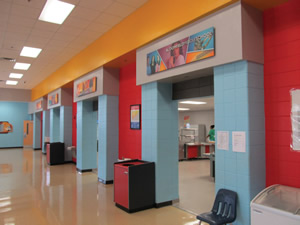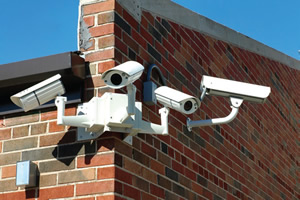Hand in Hand
- By Michael S. Dorn
- 03/01/15

PHOTO COURTESY OF SAFE HAVENS INTERNATIONAL
Do metal detectors, security cameras, visitor management systems and other security technologies make schools safer? This is a valid question at a time when school officials are investing heavily in school security technologies. Indeed, schools that rely primarily on security technologies that are not complemented by a variety of human approaches are typically less safe. Just as models focused primarily on mental health services are less effective, attempting to make schools safer through an emphasis on a single security technology approaches can also be unreliable. Comprehensive approaches based on formal assessment processes and that appropriately combine physical security measures with human approaches provide the most effective school security strategies.
For example, in 1999, United States Attorney General Janet Reno requested an external evaluation of the Bibb County Public School System model for violence reduction. This evaluation demonstrated that the district’s combined use of metal detectors, school district police officers, multi-disciplinary threat assessment, awareness efforts and a wide range of other measures was among the most effective school violence reduction programs in the nation at the time.
The Bibb County Model was the only K-12 program to make the final cut out of 60 promising programs selected from more than 400 violence reduction programs evaluated by the Hamilton Fish Institute on behalf of the Justice Department. Over a 10-year period, using rigorous mandated reporting requirements, the district saw a measured decrease in student weapons violations of more than 90 percent, a reduction in crimes committed by students of more than 80 percent, as well as significant improvements in the district’s truancy and dropout rates.
Multiple students were injured with edged weapons and a record 18 guns were recovered from the district’s 25,000 students in a single year prior to implementation of the district’s random surprise metal detection program and these supportive measures being implemented.
Previously, the Bibb County model was featured as the cover story for School Planning and Management in the May, 1998 edition. A wide array of organizations ranging from the National Association of School Resource Officers, the United States Department of Education and the International Association of Chiefs of Police also highlighted the model. Several concepts developed in the district are still utilized in many schools across the nation. One important lesson noted by the external evaluators was the fact that the Bibb County model was holistic and was not primarily reliant upon any single strategy. While metal detection was a critical success strategy, the district also had two prevention teams, each comprised of a school social worker and a school district police officer. These teams worked to reduce truancy and to assist building administrators with assessing situations where threats to carry out shootings, bombings or suicide had been made by students or other parties. During the 10-year period, the district averted six imminent planned shootings at secondary schools and athletic events, stopped five adults with loaded guns from carrying out attacks at elementary schools and stopped a planned bombing of a middle school.
While this example demonstrates the importance of the human aspect of school security, a blending of school security technologies can also be extremely important. We will examine how three very different school security technologies can be combined not only to address an array of potential threats, but how each can help make the others more effective. For illustration, we will discuss school security technologies — security cameras, visitor management systems and metal detectors.

PHOTO © LARRY LAWHEAD/SHUTTERSTOCK
Security cameras
Among the most commonly utilized school security technologies, security cameras can help improve security and enhance the ability to resolve incidents in the neighborhood around a school, in parking lots and grounds, at entry points and in a variety of interior areas. Like metal detectors, security cameras have their limitations and should be viewed as a component for school security rather than as THE solution. Security cameras can be valuable tools to help identify perpetrators after the fact and to help administrators resolve differing accounts centering around behavioral issues such as fights and bullying. There are also opportunities to use security cameras as an effective prevention tool.
For example, one of the most effective means to prevent a variety of types of incidents such as bullying, drug activity, smoking, gang activity and fights among students is to improve student supervision. Security cameras can be a highly effective tool to help administrators to quickly spot check and document that staff in are properly positioned in different parts of the campus during key times, such as passing times and lunch periods. While in-person leadership is also very important, an administrator with a robust camera system can rapidly check key areas in a massive high school with several thousand students in a matter of minutes. This is often not possible by attempting to walk the campus during a single passing time. We also encourage our clients to periodically evaluate staff supervision, student positioning and traffic flow via parking lot cameras to supplement what they see when supervising in person. High angle exterior cameras can enable administrators to spot potentially deadly situations so repositioning of staff and/or students can be accomplished before someone gets hurt.
Security cameras can also help augment metal detection and visitor management systems. For example, video from security cameras can provide better documentation if weapons are recovered at a weapons screening station, or help resolve allegations that personnel have conducted an unlawful search. Similarly, I have seen many instances where school officials have successfully used school security cameras to enhance their visitor management approach.
Visitor management systems
Visitor management systems are one of the most practical school security technologies for many schools. Modern visitor management systems are truly remarkable. The can also be invaluable tools to help school officials detect potentially dangerous visitors. They can also be used to help staff and students spot an intruder who has found a way to defeat a school’s access control. When combined with properly enforced requirements that all adults in a school wear an appropriate photo staff identification card or a time sensitive visitor badge, security can be dramatically improved with the aid of visitor management systems. Our analysts’ experiences conducting penetration tests have demonstrated that it is much harder to gain access to students, sensitive information and valuable property in schools with properly utilized visitor management systems. As with security cameras, an effective visitor management system can also help reduce the chances that a student or visitor can slip into an alternate entryway to bypass a weapons screening checkpoint.
Metal detectors
Metal detectors are among the less commonly used school security technologies. Though ineffectual utilization of metal detectors will reduce reliability, there are situations where metal detectors can provide a level of prevention that is not possible through other means. Multiple school districts have demonstrated significant reductions in weapons incidents through properly implemented metal detection programs combined with other measures such as multi-disciplinary threat assessment. As one example, Bibb County School Police Officer Levi Rozier spotted a pentagram on a student’s keychain during a metal detection check at Westside High School in Macon, Ga. Talking to the student privately, he became concerned and initiated a formal threat assessment in concert with a school social worker and a building administrator. A search of the student’s locker led to the recovery of a written suicide pact involving the student’s girlfriend. Both students admitted they were going to kill themselves that evening. For situations where the threat level makes it appropriate, metal detection can enhance the level of protection that would be offered by security cameras and visitor management systems alone.
While schools should carefully avoid creating prison-like environments, properly implemented security technologies will not create that feeling for the majority of students, visitors and parents. Our analysts often formally measure this with surveys, interviews with students and other tangible means.
For example, I conducted penetration tests for an Illinois school district that heavily utilizes all three of these technologies, along with armed police officers and 19 to 20 uniformed security officers per high school. Posing as a reporter from Education Week, I interviewed students at each high school with no school staff present. As I detailed in my report to the superintendent, every student I spoke to told me they felt safer due to the intensive security measures. Upon further inquiry, every student commented that the polite, professional conduct of the administrators, security personnel and police officers made them feel welcome while feeling free from fear of violence in their school. While these measures are clearly not appropriate for every school, this example show that how you implement physical security is just as important as the types of school security technologies you use.
The author of 27 books including “Staying Alive – How to Act Fast and Survive Deadly Encounters”, Michael Dorn’s school safety work has taken him to Canada, Mexico, Europe, Africa, Asia and the Middle East. Michael welcomes questions and reader feedback at www.safehavensinternational.org.
This article originally appeared in the issue of .